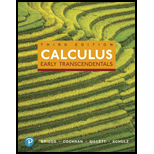
(a)
Whether the statement “The level curves of
(a)
Answer to Problem 1RE
The statement is true.
Explanation of Solution
The given function is,
Let
Take log on both sides.
Here,
Therefore, the statement is true.
(b)
Whether the equation
(b)
Answer to Problem 1RE
The statement is false.
Explanation of Solution
Given:
The equation is
Calculation:
The given equation is
When
The functions are
Therefore, the statement is false.
(c)
Whether the function f satisfies the derivative
(c)
Answer to Problem 1RE
The statement is false.
Explanation of Solution
Let the function f has a continuous partial derivatives of all orders.
Then prove that
For example, assume
Obtain the value of
Take partial derivative of the function f with respect to x and obtain
Thus,
Take partial derivative of the equation (1) with respect to x and obtain
Hence,
Again, take partial derivative for the equation (2) with respect to y and obtain
Therefore,
Obtain the value of
Take partial derivative of the function f with respect to y and obtain
Thus,
Take partial derivative of the equation (1) with respect to y and obtain
Hence,
Again, take partial derivative for the equation (2) with respect to x and obtain
Therefore,
From above, it is concluded that
Thus,
Therefore, the statement is false.
(d)
Whether the gradient
(d)
Answer to Problem 1RE
The statement is false.
Explanation of Solution
Given:
The surface is
Theorem used:
The Gradient and Level Curves:
“Given a function f differentiable at
Description:
The given surface is
By above theorem, it can be concluded that the line tangent to the level curve of f at
Thus, it does not satisfy the given statement. Because, it is given that the gradient
Here,
Therefore, the statement is false.
Want to see more full solutions like this?
Chapter 15 Solutions
MyLab Math with Pearson eText -- Standalone Access Card -- for Calculus: Early Transcendentals (3rd Edition)
Additional Math Textbook Solutions
College Algebra (7th Edition)
Pre-Algebra Student Edition
Calculus: Early Transcendentals (2nd Edition)
Introductory Statistics
University Calculus: Early Transcendentals (4th Edition)
- Suppose that a particle moves along a straight line with velocity v (t) = 62t, where 0 < t <3 (v(t) in meters per second, t in seconds). Find the displacement d (t) at time t and the displacement up to t = 3. d(t) ds = ["v (s) da = { The displacement up to t = 3 is d(3)- meters.arrow_forwardLet f (x) = x², a 3, and b = = 4. Answer exactly. a. Find the average value fave of f between a and b. fave b. Find a point c where f (c) = fave. Enter only one of the possible values for c. c=arrow_forwardplease do Q3arrow_forward
- Use the properties of logarithms, given that In(2) = 0.6931 and In(3) = 1.0986, to approximate the logarithm. Use a calculator to confirm your approximations. (Round your answers to four decimal places.) (a) In(0.75) (b) In(24) (c) In(18) 1 (d) In ≈ 2 72arrow_forwardFind the indefinite integral. (Remember the constant of integration.) √tan(8x) tan(8x) sec²(8x) dxarrow_forwardFind the indefinite integral by making a change of variables. (Remember the constant of integration.) √(x+4) 4)√6-x dxarrow_forward
- a -> f(x) = f(x) = [x] show that whether f is continuous function or not(by using theorem) Muslim_mathsarrow_forwardUse Green's Theorem to evaluate F. dr, where F = (√+4y, 2x + √√) and C consists of the arc of the curve y = 4x - x² from (0,0) to (4,0) and the line segment from (4,0) to (0,0).arrow_forwardEvaluate F. dr where F(x, y, z) = (2yz cos(xyz), 2xzcos(xyz), 2xy cos(xyz)) and C is the line π 1 1 segment starting at the point (8, ' and ending at the point (3, 2 3'6arrow_forward
 Elements Of Modern AlgebraAlgebraISBN:9781285463230Author:Gilbert, Linda, JimmiePublisher:Cengage Learning,
Elements Of Modern AlgebraAlgebraISBN:9781285463230Author:Gilbert, Linda, JimmiePublisher:Cengage Learning,
